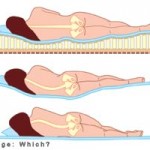
Which Type of Mattress Is Good for Health?
Do you get enough support from your mattress? There are links between your mattress type and health, so having a supportive mattress is good for so much more than just getting a good night’s sleep.
When you go mattress shopping, you should consider several points other than your budget and the mattress size. You should know how to pick out a mattress that gives you a well-rested and healthy night’s sleep every night. We’ll outline what you should know next.
Your Old Mattress Type and Health Risks
If your current mattress is years old, or you bought a mattress that doesn’t suit your sleeping style, it could harm your health. Since you spend a considerable amount of your life sleeping, this allows for dirt, skin cells and moisture residue from sweat to accumulate on and in your mattress. Mould and mildew can form, and it can also attract bacteria and allergy-causing dust. In turn, this can trigger respiratory problems.
If you find yourself suffering from neck pain, backaches or aching in your joints, your mattress can be at fault. As you use your mattress, it’ll gradually change shape and get less supportive. Your sleeping posture and bodies can change over time too.
You may find yourself feeling groggy or tired, and this can impact your concentration and put you at a higher risk for motor vehicle accidents. Depression and anxiety are real risks as well, and they can get worse at time goes on.
Choosing a Mattress Firmness
Mattresses come in different firmness levels. Even if you pick out a luxury mattress, it won’t help you get a good night’s sleep if it’s a bad match for your preferences or sleeping style. Taking the time to test the different firmness levels is essential to finding your mattress type.
- Firm – A firm mattress is excellent for people who routinely sleep on their stomachs because it can help keep your spine in alignment while taking pressure off your lower back. Most firm mattresses come with either high-density foam or heavy-gauge springs. They’re great at distributing weight evenly, so they’re an excellent choice for heavier or taller people.
- Medium-Firm – A medium-firm mattress is a good choice for people who sleep on their backs. If you get your mattress made from memory foam or latex, it’ll keep you comfortable, support you and keep your spine in alignment. You can get mattresses with soft comfort layers made from cotton or natural wool for added comfort.
- Soft- Light sleepers or petite people can benefit from a soft mattress made from light foam or natural latex. For side sleepers, a soft mattress will help relieve tension and pressure on your shoulders and hips, prevent injuries and reduce tossing and turning. The top layer of soft mattresses also features a softer foam to increase your comfort level.
Medium-firm and soft mattresses use Euro top or pillow top layers to help add cushion and avoid pressure points. The difference between these two is how the tops adhere to the mattresses. The pillow top has a gap between the mattress and pillow top layer because it gets sewed separately. Euro tops get sewn as a whole, and they have additional padding under the top layer.
The Four Mattress Types
You can generally break the different types of mattresses down into four broad categories. Once you choose a mattress firmness, it’s time to pick out a mattress type. This choice requires special consideration as well because it can make your health problems like allergies or arthritis worse if you choose the wrong type for your needs.
- Innerspring
An innerspring mattress is more traditional, and it comes with coiled springs made of strong metals like steel that gives you a supportive sleep. They’re typically more affordable than other types, but they wear out quicker. Cheap innerspring mattresses usually come with a single set of springs. If you buy a luxury model, you get independent pocket springs that give you customised support to the different areas of your body.
You want to check the mattress’s coil gauge when you shop. The thicker the gauge is, the thicker the spring, and the more support you get. If you are overweight or have back problems, this is typically the recommended mattress because it makes it easier to get out of bed and it offers excellent support.
- Latex
Latex mattresses can be more expensive, but they last up to 25 years. It also makes it easy to get in and out of bed. They’re usually medium-firm or firm, and they’re great for people who get too hot when they sleep because latex breathes. Latex is also antibacterial and antimicrobial, so this factor can prevent allergy attacks while being easier to clean.
- Memory Foam
Memory foam mattresses conform to your body through repeated use to give you a customised sleeping experience. They can help to relieve pressure points along your body and give you a healthy blood flow while you sleep. Memory foam is great for people who sleep on their sides, and it can be just as supportive as traditional innerspring mattresses. Finally, it can come treated with antimicrobial and antibacterial layers to keep it clean.
- Hybrid
If you have trouble deciding between a traditional spring mattress or a more modern foam mattress, a hybrid mattress can give you both. You’ll typically get customised support with zoned springs, and varying layers of memory foam in different thicknesses. You can even tailor both sides of the mattress to support different sleeping styles.
Be Aware of Toxic Mattresses
Some older mattresses come with polybrominated diphenyl ethers (PBDEs) and other toxic compounds. They may also contain VOCs (volatile organic compounds), and they have links to health problems like hearing and mood disorders, thyroid issues, impotence, cancer and birth defects. Be sure you ask about non-toxic mattresses.
Mattresses and Pregnancy
A worn-out or old mattress can cause issues for pregnant women. Most women choose a memory foam mattress with medium firmness. You get plenty of support and can easily get in and out of bed. Also, get a non-toxic mattress because it’s healthier for both mum and baby.
Cleaning Your Mattress
Ideally, you want to clean your mattress monthly, but at least twice a month if someone has allergies. A vacuum cleaner will remove dirt or dust from the mattress’s surface, and then you can sprinkle a small layer of baking soda to soak up any moisture and remove stains. Don’t get your mattress wet because this can cause mildew and mould growth. A mattress protector can help you keep your mattress cleaner for longer, and you should wash your bedding every two weeks.
Average Mattress Lifespan
Your mattress’s average lifespan depends on the quality, material, individual needs and usage. However, you should consider changing your mattress:
- Innerspring – Every eight years
- Latex- Every 20 years or more
- Memory Foam – Every eight to ten years
- Hybrid- Every 10 to 12 years
If your mattress isn’t giving you the support you need before this time, you should consider replacing it sooner.
Shop Bedworks for Your New Mattress!
No matter your preferred mattress type, Bedworks has the perfect one in stock. We invite you to shop our stock and reach out with any questions you may have!





